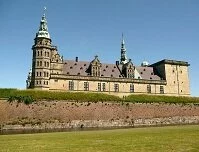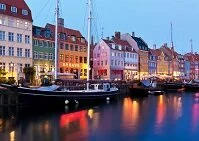
Kronborg Castle
Another historic structure, the Kronborg Castle (1500-1600s) near Helsingor (Elsinore) is, like Roskilde Cathedral, a building with significant influence in multiple realms. Architecturally, this castle is in the Renaissance style and is again one of the best examples of the style in Denmark. This castle is also owned by the royal family, but today most foreigners only know it as the location of Shakespeare's Hamlet.
The next major influence on Danish architecture came in the late 1700s and early 1800s when the neo-Classical movement arrived in Copenhagen. Many of the city's municipal buildings and churches were built in this new style as the court house, Thorvaldsen Museum, and Church of Our Lady are all neo-Classical buildings.

Nyhavn Street in Copenhagen
Denmark has experienced a more recent architectural boom in the 1900s and 2000s. Copenhagen's town hall (1892-1901) is a unique structure with hints of neo-Renaissance and neo-Gothic architecture. More recently, many of Denmark's buildings have been more original as modern architecture has taken hold and for much of these last two centuries the country has had the financials to construct these marvels. Many of these building are in Copenhagen, which remains to this day the best example of Denmark's architectural history as there are buildings from nearly every time period that can still be explored.